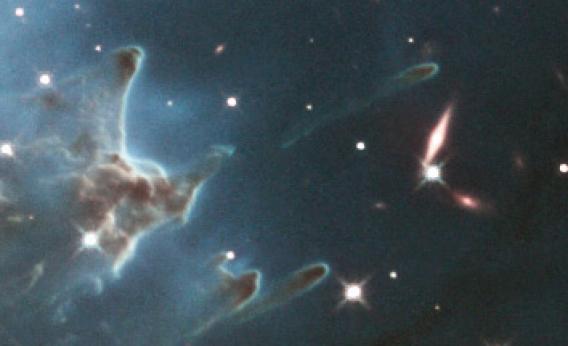Create a free profile to get unlimited access to exclusive videos, sweepstakes, and more!
For Hubble’s 24th Birthday: A Stellar Nursery Being Destroyed by the Stars
It Created

Today marks the Hubble Space Telescope’s 24th birthday; on this day in 1990 the Space Shuttle Discovery roared into space with Hubble in the payload bay, and the next day astronaut Steve Hawley deployed the telescope into orbit. For years a flaw in the mirror degraded the resulting observation but upgrades to the cameras onboard the observatory compensated, and ever since Hubble has been wowing astronomers and the public alike with its grand view of the Universe.
Every year on or about this date, the folks at the Space Telescope Science Institute release a gorgeous image to celebrate (see Related Posts below). This year is no exception; in fact, this year’s is one of the best: NGC 2174, a vast stellar nursery being blasted away by the ferocious light and heat of nearby stars.
[Click to embiggen, or get the even vastier 1860 x 1860 pixel version.]
Holy wow! NGC 2174 is about 6,000 or so light years away toward the constellation of Orion, and is a huge cloud of gas and dust enthusiastically forming stars at a brisk clip. And I do mean huge: Even at that terrifying distance, the entire cloud is as big in the sky as the full Moon. This small section of it seen by Hubble is a half-dozen light years across all by itself, and the whole cloud is more than 10 times larger.
The gas and dust in NGC 2174 have been forming stars for millions of years, and it is populated with quite a few young, massive, hot, and very luminous ones. Just off to the right in the picture, outside the field of view, is a whole cluster of them. These stars are so bright that their light and winds of subatomic particles are eating away at the cloud, dissolving it. What you’re seeing here is the edge of that erosion front, the border between material already blown away and material that is soon to be destroyed by it.
This region is studded with bumps and long fingers of material; these are denser knots where stars are forming deep within. The gas and dust are thicker here and resist erosion. The knots act like sandbars in a stream, forming graceful arcing heads upstream and long tails pointing away from the hot stars. The very edges of the heads are glowing as they undergo the onslaught from the nearby superstars, creating a bright limb around them.
I can’t help but think they look like sperm (though we’re talking gametes a trillion kilometers long …). The metaphor isn’t a bad one, since these are the sites where stars are being born. And it’s a race to see which knots can actually birth their stars before being blown away by the winds. The similarity in shape is due to similarity of forces; both are sculpted by hydrodynamics, the motions of fluids. On the microscopic side sperm get an advantage by being sleek and streamlined so they move more efficiently through a fluid; on the cosmic side the knots get sculpted as the fluid flows past them. Animal birth, star birth: The motion of the medium is relative.
One last thing I want to point out, too. In the detail shot above you can actually see a few background galaxies. That’s amazing! The dust littering NGC 2174 is very efficient at absorbing light, and it’s rare to see more distant objects in pictures of star-forming regions. In this case though we have an ace in the hole: This image was made using infrared filters!
Infrared light is better at getting through the dust, so some galaxies are able to pierce the muck. Note that as you look more to the left in the big Hubble image you see fewer stars and galaxies, and things get redder. The really thick dust is on the left, and it blocks almost everything behind it. But some of the stars embedded in the dust manage to get their reddest light through. I can still spot a handful of galaxies there; I imagine these are very luminous beasts indeed to be able to shine through, pouring out infrared light. Perhaps they themselves have huge clouds like NGC 2174, vigorously forming stars and blasting infrared light out into the Universe, and it’s that glow we see here.
The Universe is very meta sometimes.
Anyway, happy birthday, Hubble! It was a pleasure to work on you for all those years, and even more of a pleasure to continue writing about your exploits now, nearly two and a half decades after you got your start.
Related Posts
Hubble’s Knight to Remember (2013, 23rd)
A Stunning Star Factory for Hubble’s 22nd (2012, 22nd)
Happy Birthday, Hubble (for Real This Time) (2011, 21st)
Hubble Celebrates 20 Years in Space With a Jaw-Dropper (2010, 20th)
Hubble’s Fountain of Youth (2009, 19th)
When Galaxies Collide (2008, 18th)
Hubble’s 17th: Chaos, Birth, and Near-Death (2007, 17th–worth it for the last image alone)
Happy Birthday HST! (2006, 16th)
Hubble’s Anniversary (2005, 15th)


























